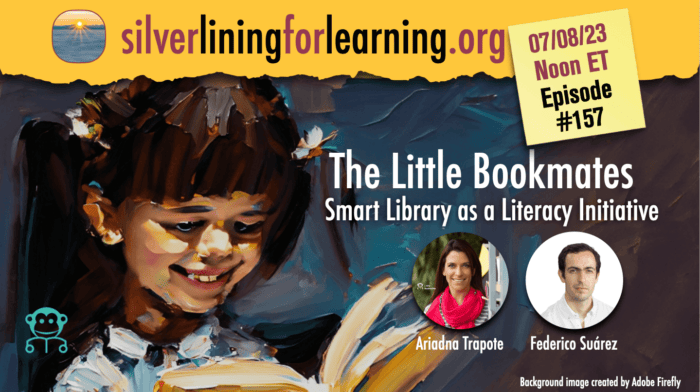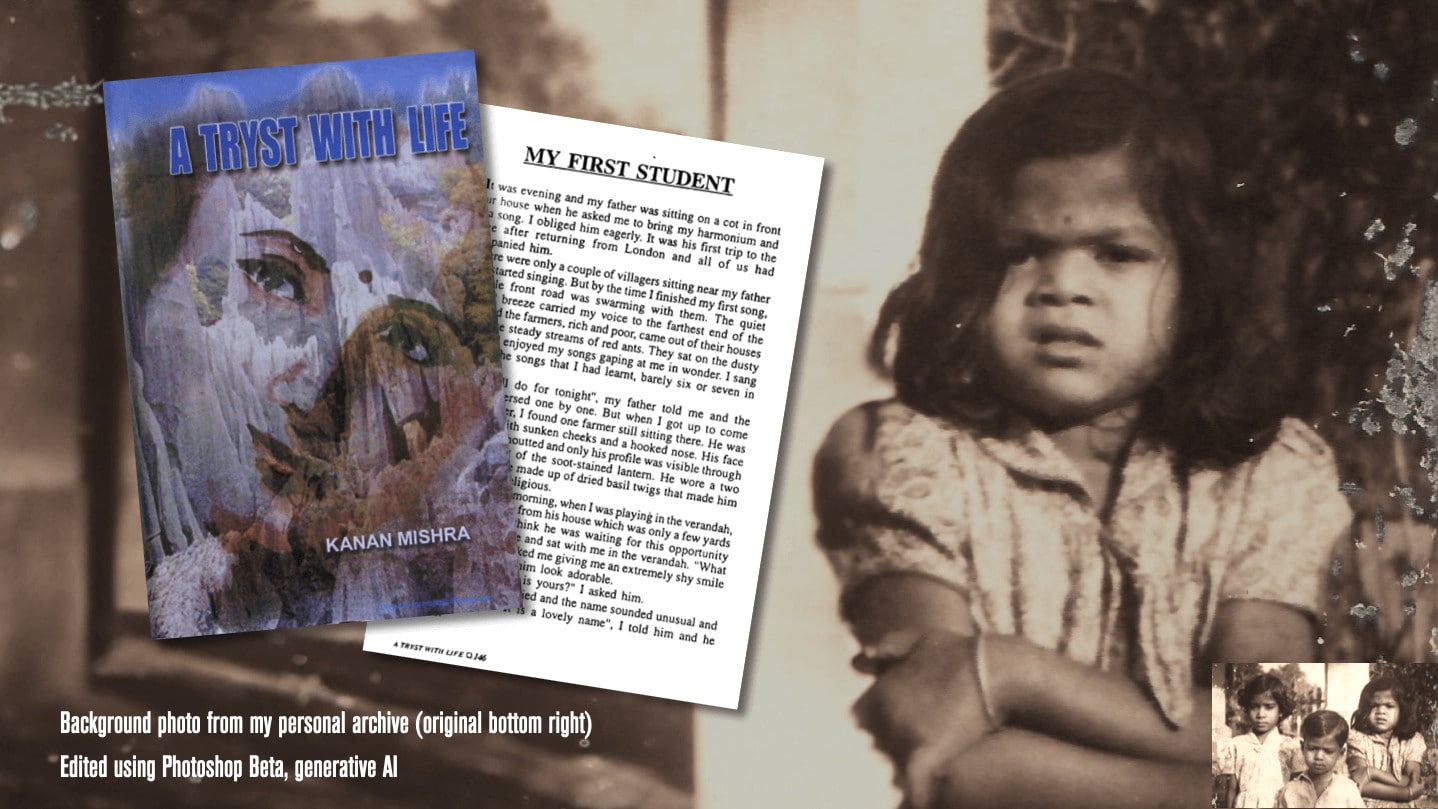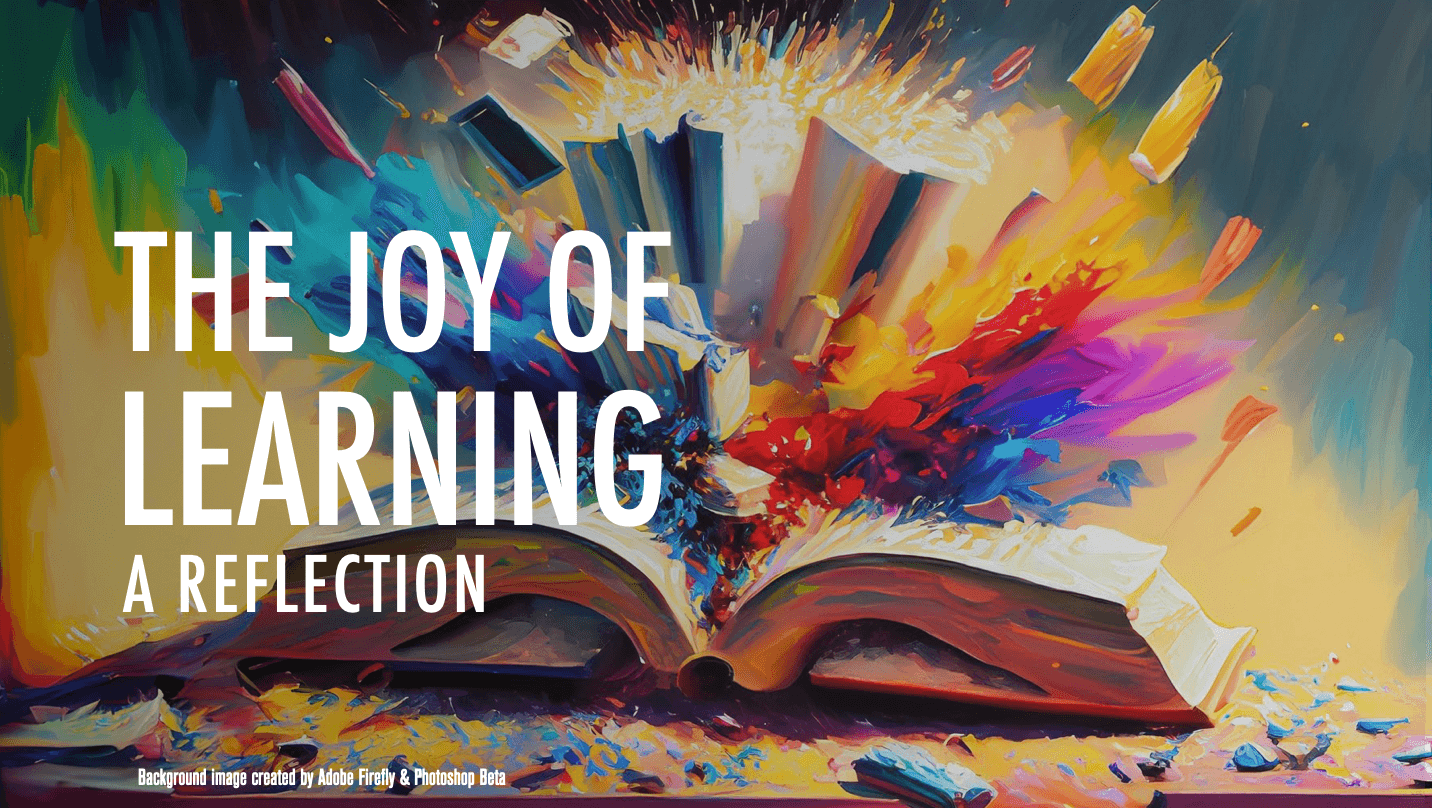What is this thing called learning? What does it mean to learn something? What makes us want to learn? Why is it fun? Why do we want to know? Even as educators, we often don’t take the time to ask ourselves these foundational questions. So it is rewarding when we get a chance to do so.
These questions came to mind, while recording the most recent episode of the Silver Lining for Learning webinar. In in this episode (titled: The Little Bookmates Smart Library as a Literacy Initiative) we had the great pleasure of speaking with Ariadna (Ari) Trapote and Federico (Fede) Suárez, two edupreneurs from Mexico leading an initiative called Little Bookmates. As Chris Dede wrote in the introduction to the episode:
If the large majority of printed books in the world are in many households’ bookshelves, why not share these effectively instead of having them sitting idly for 99% of the time? Through a subscription model, lean algorithms and hard copy books, Little Bookmates’ clients have already read more than 100k books across Mexico, Colombia and soon the US. What started as a small-scale enterprise in Ari’s house has grown into a franchise model with a powerful platform that can virtually turn any living room in the world into a book lending hub.

We had a wonderful discussion, about the power of books and ideas to change people’s (particularly children’s lives). You should watch the episode in its entirety, or listen to it on your favorite podcast app.
By the end of the episode I was just reminded of a bunch of different moments in my own life where books and learning had transformed me and my understanding of myself and my place in the world. I was particularly reminded of two stories, one fictional and the other a semi-autobiographical piece written by my mother. I share both below.
The first memory that came up was of a lovely scene in Satyajit Ray’s movie Aparajito (the second movie in his acclaimed Apu trilogy). To provide some context, Apu lives with his mother after his father’s death early in the movie. Despite their extreme poverty, his mother manages to send him to school. In a short scene, filmed in striking black and white, Apu excitedly shares with his mother things he has learned, both in school and from his own reading. There’s a lantern standing in for the sun and a small ball that represents the planet, and Apu showing his mother how eclipses happen. There are two tins of water at different levels and Apu siphoning in water, using a pipe from one into the lower pan. There is Apu running in the fields, with a skirt of leaves and a toy spear screaming “Ami Africa Desher Raja” (I am the King of Africa). And finally, the little boy, having fallen asleep, while studying, having even forgotten to eat.
I saw this movie, many years ago, when I was student in high-school. And for some reason that scene has always stayed with me. Maybe because it resonated with my personal experience of reading books and how they opened the world in magical ways. You can watch the clip below:
I was also reminded of an auto-biographical piece my mother had written many years ago, echoing the same sentiment, but not for a child but an illiterate older man. It was published in her only English-language book A tryst with life, a collection of short auto-biographical pieces she wrote for newspapers and magazines. The story tells of her experience as nine-year old visiting her ancestral village from the medium-sized town she lived in with her parents (my grandparents) and siblings. Incidentally, the photo below was taken when she was approximately the age when this story occurred. The village, described, was a small, typical settlement in the eastern-Indian state of Odisha, where subsistence farming was the primary livelihood. Finally, the language spoken in that part of India is Odia though it is spelled Oriya in the piece (as was customary till recently).
You can read the story below:

The photo on the right is of my mother when she was approximately the age that is described in her story. The original photo that was used for the background in given in the bottom right. The two other children in the photograph were magically deleted using Photoshop Beta’s Generative AI tool.
My First Student by Kanan Mishra
Mishra, K. (2001). My first student. In My Tryst with Life. Apurbo Publishing, Bhubaneswar.
It was evening and my father was sitting on a cot in front of our house when he asked me to bring my harmonium and sing a song. I obliged him eagerly. It was his first trip to the village after returning from London and the entire family had accompanied him.
There were only a couple of villagers sitting near my father when I started singing. But by the time I finished my first song, the whole front road was swarming with them. The quiet nocturnal breeze carried my voice to the farthest end of the village and the farmers, rich and poor, came out of their houses in lines like steady streams of red ants. They sat on the dusty ground and enjoyed my songs gaping at me in wonder. I sang almost all the songs that I had learnt—barely six or seven in number.
That will do for tonight. My father told me, and the villagers dispersed one by one. But when I got up to go home for dinner, I found still one farmer sitting there. He was lean and fair with sunken cheeks and a hooked nose. His face was partially silhouetted and only his profile was visible through the reddish light of the soot-stained lantern. He wore a two stranded necklace made up of dried basil twigs that made him look somewhat religious. Next day in the morning, when I was playing in the verandah, I saw him emerging from his house, which was only a few yards away from ours. I think he was waiting for this opportunity to meet me. He came and sat with me in the verandah. “What is your name?” He asked me.
“Kanan. And what is yours?” I asked him.
“Nirmalya.” He replied and the name sounded unusual and wonderful to me.
We began talking. He asked me innumerable questions- about my music lesson, about the town I lived in, and about my school. All my answers seemed to fascinate him very much and finding such an impressionable listener, I went on talking enthusiastically.
“What do you study in the school.” Nirmalya asked me after some time.
“Oh. We study so many things—Oriya, arithmetic, geography…” I was going to prolong my list by adding science and history, but Nirmalya interrupted.
“…Geography what is geography?” Oriya, he knew. Arithmetic he could understand. But geography was beyond his comprehension.
“In geography, we learn about the earth, the earth that you and I live in,” I explained.
“And what do you learn about the earth…” Nirmalya asked again with the inquisitiveness of a child.
“We read so many things, for example, we read that the earth moves around its axis.” I was going to tell him that this is what causes day and night, but he interrupted me again.
“Oh No, How can the earth move? If it moves, won’t we lose our balance and fall down.” Nirmalya seemed puzzled.
I was sure in my knowledge that the earth moved around its own axis, but I didn’t know how to explain it to him. But then I do not know how and why a strange comparison came to my mind.
“Well, you must have driven a bullock cart” I asked Nirmalya and he nodded. He had done it many times.
“When the cart moves the wheels also move, don’t they?” I asked again.
“0f course the wheels move around the axle. Otherwise, how would the cart move?” Nirmalya laughed and answered.
“Suppose you leave a tiny red ant in the spoke of a moving wheel. Will the ant walk about freely or fall down?” I asked him again.
Nirmalya thought for a few seconds. “No, the ant won’t fall down. It would move about.” He said after some thought.
“See. You yourself admit that. Similarly compared to the earth, we are exceedingly tiny creatures, much smaller than the red ant. So even if the earth moves, we don’t feel it and we don’t fall down.” I told him smiling.

I had won my point and Nirmalya was convinced. He sat spellbound for a few minutes uttering exclamatory remarks about my wisdom and left for his home.
From that day onwards, Nirmalya would come almost daily and would sit with me anytime he was free. He would sit hunchbacked on the ground clutching both his knees tightly with his crossed arms and would ask me questions about my studies and within a week I told him all that I had learnt in the school. I told him about the story of Gautam Buddha and I told him about what the Red Cross did. I told him the names of the nine planets, and I also explained to him as to how the seasons changed. I was in class five (fifth grade) then and my own knowledge was less than rudimentary, and it seems laughable now that I tried to impart that knowledge to Nirmalya. But he drank deep of whatever I said and was always eager to know more.
In a few days we returned to the city and I didn’t have the opportunity of seeing Nirmalya again after that and, moreover, there really was no reason for me to remember him. But I did remember him much later in my life.
I was teaching geography to my little son. The earth goes round its axis once in twenty-four hours, I told him, and he asked me the same question that Nirmalya had asked me once so long ago. Of course, by this time, I knew about the gravitational pull of the earth and told him so. And it was then that the picture of Nirmalya came to my mind. The emaciated looking farmer innocent and illiterate, with the sacred necklace of dried basil twigs around his thin bony neck, sitting hunch-backed on the ground and listening to the chattering of a little girl, flashed back in my memory.
I am yet to see such tremendous thirst for knowledge in anyone else.

The key question(s)
A question we need to ask ourselves, as educators, is this: Why is Apu, a poor little boy, who has barely enough to eat, excited by the fact that water can flow over an edge? And that the earth moves around the sun (not vice versa)? Why was Nirmalya, an illiterate villager in a remote village in India, so captivated by ideas and learning (that too from relatively ignorant nine-year old)?
I think we often provide instrumental justifications for the value of learning: It will help us land a job; It will allow us to function productively in society; It will prepare us for the future and so on…. To be fair, I don’t necessarily disagree. I am am personally involved in many such projects. It is not happen-chance that I co-host a podcast called Learning Futures, which is part of a broader Learning Futures Initiative, that I help lead. So, it is not that I don’t value and appreciate these reasons, but at the same time, I strongly suspect, these reasons are not as foundational as they are made out to be. As T.S. Eliot wrote, in one of my favorite poems (The love song of J. Alfred Prufock),: “That is not it at all.”
I think learning is its own reward. We love it for its own sake, for the insights it gives us, about ourselves and the world. Oppenheimer once said:
Understanding is a lot like sex. It’s got a practical purpose, but that’s not why people do it normally.
What both these stories, (one fictional and the other autobiographical) bring home to us, is a foundational truth: Learning brings us joy. I believe that we often overlook this aspect of learning. (I have written and spoken about this elsewhere, particularly when speaking about the power of ideas, and the role that aesthetics plays in learning).
I am deeply grateful to Ari and Fede, guests on our webinar, for taking time to speak with us about their project, and all the wonderful memories and ideas it helped generate.
Aparijito Postscript
#1
As I went looking for the clip from Aparijito I ended up watching segments of the film that I had forgotten, and aspects even of the clips that I did remember that I had overlooked. I have written elsewhere about the fictions we create, and how, they, in turn create us. My recollection of the clip was that of a solitary child, learning to love learning, and sharing his excitement with his mother. What I had forgotten was the underlying poignancy of the scene as captured by the expression on the mother’s face as she watches her child grow and change. She is excited by his excitement and yet, at the same time, dreading how this will change things between them, subtly foreshadowing, the inevitability of what is to come. I know something similar happened to me and my parents as well. I left home at 18, and though there were ups and downs, this urge to learn and grow, took me far away from them, both geographically and emotionally. I am clearly more attuned to this today, than I was when I first saw the movie, decades ago.
#2
This emphasis on the individual, (me as Apu) also hid from me another important fact. The role that others play making us who we are. The movie has many individuals, and institutions, who early on, recognized Apu’s love for learning, his talent and then decided to do something about it. This is most apparent in the clip below, which in the movie, comes just before the clip I included above. It shows how Apu is recognized by his teacher and school, who see something in this child and choose to act on it. They help him dream things that he didn’t even know were possible.
These are the educators who change our world, something I am far more sensitive to today, as a professor and educator, than I was, when I saw the movie the first time. Back then, I saw myself in the clip, but not all the other people who had been there for me (as they were there for Apu). You can see that clip from the movie, below:
Aparijito Post-Postscript (July 10)
#3
As I was writing these postscripts, I realized something extremely interesting that Satyajit Ray the director had done in these two clips. As must be clear, I have introduced the clips from Aparijito in reverse order in this blog post. The clip with the principal comes just before the clip with Apu sucking on the pipe to make water flow from the upper vessel to the one lower in height. What is interesting is that there is a reverse symmetry in how these two scenes are edited. Consider the sequence of examples the principal gives to Apu: He starts with telling him that Apu needs to work hard (that part is not included in the clip, so take my word for it), and then tells him about Livingston’s travels in Africa, mentions the names to two scientists, Galileo and Archimedes. Just as he is saying Archimedes, the scene dissolves to Apu experimenting with the pipe and water. And the scenes that follow trace out the same ideas, but in reverse order. Archimedes comes first (the experiment with water), then comes Galileo (explaining eclipses to his mother), then Livingston (the whole Africa dance) and finally, exhausted from studying he is shown asleep on his books, having done his part of the bargain, of working really hard. There is a palindromic ABCD-DCBA structure in the editing that I had not noticed before. I am pretty sure it was by design. How cool is that.
#4
Watching the clips again after so many years, also highlighted another issue that had never crossed my mind when I had watched the movie the first time. It is most obvious in the scene of Apu running around dressed up in what can only be described as a crude stereotype of someone from Africa—a deeply racist portrayal. This is in large part because the world has changed and something that would be acceptable in the 1950’s makes us cringe today.
But there is a deeper issue here and that has to do with the colonialism and its ongoing pernicious influence on Indian society, which is not surprising, given this movie was released just 9 years after India got independence from the British. This colonial influence can be seen in the books the principal recommends, the memoirs of Livingstone and his travels in Africa. And in the names of the scientists he references for young Apu: Galileo and Archimedes. No Aryabhatta. No Charaka, and no Bhaskara. This is also revealed also in the principal’s musing to himself that the only way of Apu to grow and progress is by improving his English.
Let me be clear about what I am saying here. I am not saying that the movie is reduced in any way by these scenes. The movie depicts it’s reality, and the reality of its time. This was true in 1956 and, it was still true, in the late ’70 and early ’80 when I was growing up. I read the same books. I knew the story of “Mr. Livingstone, I presume” before I could read Hindi or Odia. I knew of Galileo before I knew of Aryabhatta. Even today, I know more about Galileo and Archimedes than any ancient Indian astronomers and mathematicians.
This made me recognize that each of us embodies history and the past in our bodies, and hearts and minds. My grandfather was a professor, and my mother an author (with 17 books to her credit, including novels, collections of short-stories, children’s poetry and more). This meant that I had, early on, the privilege to know that a life of the mind was one that was available and accessible to me. The fact, that this was not the case for untold millions in India was not something that I gave much thought to. I received an excellent English medium education, an asset that provided me a crucial stepping stone into this globalized world, and set me up in many ways for success. It is also a fact (and a tragedy) that I can read just one of the books my mother has written—the only one she wrote in English. (Hence the only one I can actually quote from—as I did above). All the other books my mother wrote are in Odia, my mother-tongue, but a language I cannot read. I, thus, carry in me the colonial history of my country and the marginalization of its rich native heritage; while, ironically it is language of the colonizer, English, that has enabled me to be where I am today.




0 Comments